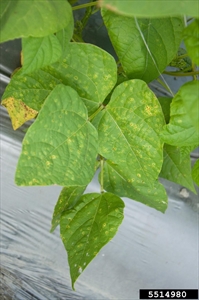Bean rust
Pacific Pests, Pathogens, Weeds & Pesticides - Online edition
Pacific Pests, Pathogens, Weeds & Pesticides
Bean (Vigna) rust (234)
Uromyces vignae
Probably wherever cowpea is grown. It is widespread in Oceania and is recorded from American Samoa, Australia, Fiji, Papua New Guinea, Samoa, Solomon Islands, Tonga, Vanuatu.
Mainly on Vigna species [Vigna marina (coastal weed), Vigna unguiculata ssp. sesquipedalis (yard-long bean), and Vigna unguiculata ssp. unguiculata (cowpea)].
The biology and life cycle of Uromyces vignae and Uromyces apendiculatus are similar. Uromyces vignae has all five spore stages but completes its life cycle on a single species, Vigna spp. This is in contrast to other rust species that have fewer life stages, and others that have all stages, but more than one host.
The rust fungus forms brown or black pustules on both leaf surfaces, sometimes in small concentric circles (Photos 1&2). The pustules also occur on leaf stalks and pods. The symptoms are very similar to those of Uromyces appendiculatus which infects Phaseolus species (see Fact Sheet No. 217). The pustules are at first light green, later reddish-brown, with distinct yellow haloes, 1-2 mm diameter.
Spread of rust fungi is by spores blown in the wind. Some spores are specially adapted for survival and have thick dark walls that can survive a long time in the atmosphere, travelling great distances. The hardiness of the spores increases the chance of infection of new bean crops. However, in the tropics, new bean crops often overlap old ones, so that survival of rust is easily assured.
The rust can develop rapidly, resulting in severe leaf damage and defoliation. However, on yard long bean in the Pacific island countries, the rust comes relatively late in the crop and the impact seems relatively small, although there has been no research to establish the impact of the disease on yield.
Look for reddish-brown, circular pustules with yellow haloes on leaves and pods, bursting to produce, large amounts of powdery reddish-brown spores. Expert examination is necessary to distinguish between Uromyces vignae and Uromyces appendiculatus.
CULTURAL CONROL
There are several ways to reduce the impact of rust on Vigna beans, apart from using fungicides:
During growth:
- Plant beans with maize as a mixed intercrop. A 'mixed intercrop' is one where the crops are planted at random; they are not planted in rows.
After harvest:
- Collect and burn or bury as much of the crop as possible.
- Do not plant one crop of bean after another in the same land; use a rotation of at least 2 years.
- Do not plant another crop of beans while the last crop is still in the ground, otherwise the rust will easily spread from the old crop to the younger one.
RESISTANT VARIETIES
There are a number of varieties with resistance to bean rust; contact agriculture authorities or seed suppliers to see if any are available in your area.
CHEMICAL CONTROL
If fungicides are needed, use mancozeb. Start to spray when symptoms first appear.
____________________
When using a pesticide, always wear protective clothing and follow the instructions on the product label, such as dosage, timing of application, and pre-harvest interval. Recommendations will vary with the crop and system of cultivation. Expert advice on the most appropriate pesticides to use should always be sought from local agricultural authorities.
AUTHOR Grahame Jackson
Infomration from CABI (2019) Uromyces vignae (rust: cowpea). Crop Protection Compendium. (https://www.cabi.org/cpc/datasheet/55871). Photo 1 Kohler F, et al. (1997) Diseases of cultivated crops in Pacific Island countries. South Pacific Commission. Pirie Printers Pty Limited, Canberra, Australia. Photo 2 Yuan-Min Shen, Taichung District Agricultural Research and Extension Station, Bugwood.org.
Produced with support from the Australian Centre for International Agricultural Research under project PC/2010/090: Strengthening integrated crop management research in the Pacific Islands in support of sustainable intensification of high-value crop production, implemented by the University of Queensland and the Secretariat of the Pacific Community.





